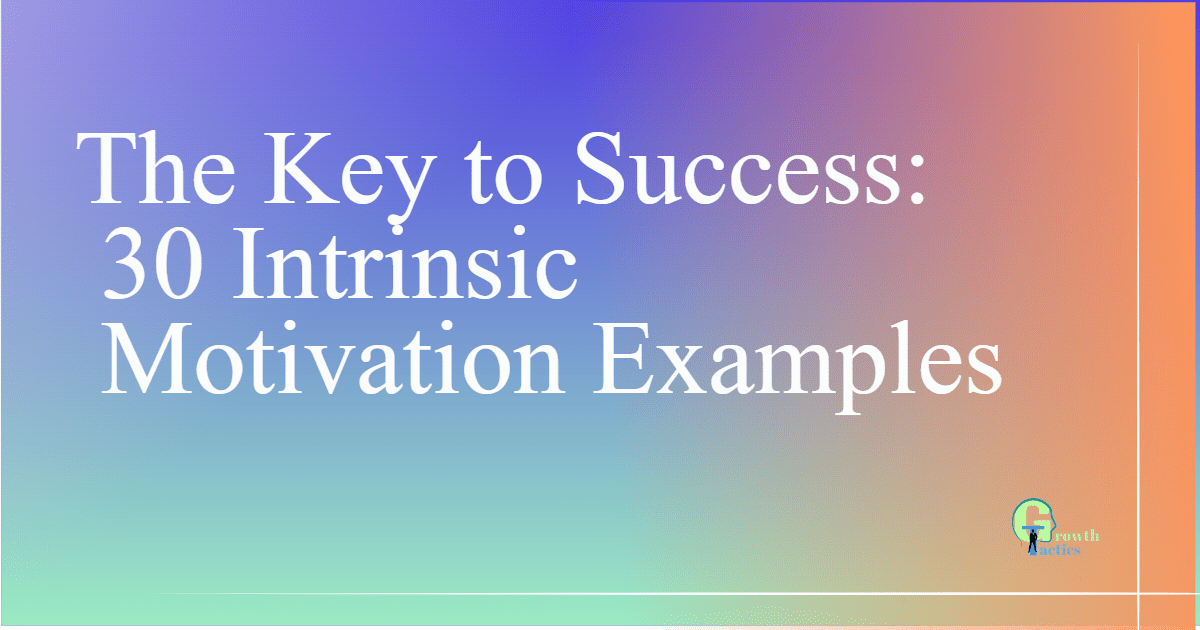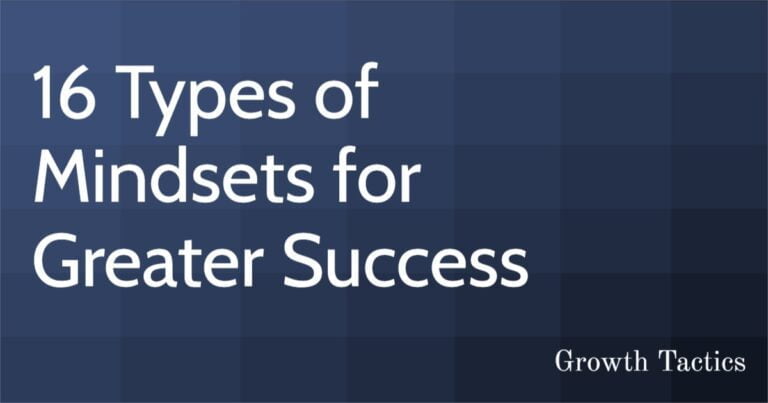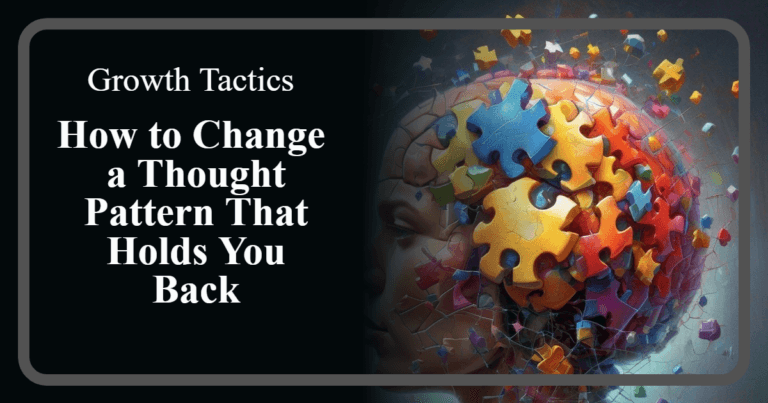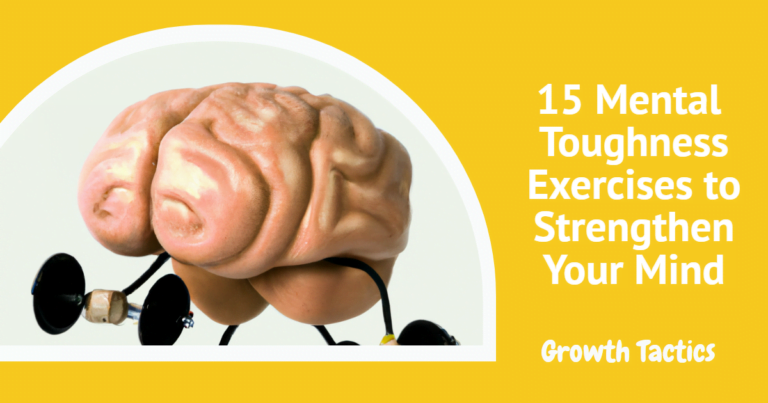Intrinsic motivation is the drive to do something because it is personally rewarding. It’s when you’re inspired by your own interests and values, not by external rewards or pressures.
In this article, we will explore the concepts of intrinsic and extrinsic motivation, highlight their key differences, and provide 30 intrinsic motivation examples to foster a better understanding.
Jump To Section
Intrinsic Motivation: Definition and Theory
At its core, intrinsic motivation refers to the internal desire, satisfaction, and enjoyment that come from engaging in an activity for its own sake, rather than being driven by external rewards or pressure. It is the inherent pleasure and sense of fulfillment that individuals experience when they are motivated by personal interest, curiosity, or the desire to improve their skills and abilities.
Intrinsic motivation arises from within, driven by an individual’s interests, values, and sense of purpose. It is not influenced by external factors such as money, praise, or recognition. Instead, intrinsic motivation is the fuel that propels individuals to engage in activities because they genuinely enjoy them and find them personally meaningful.
According to self-determination theory, a prominent theory of motivation, intrinsic motivation is rooted in three basic psychological needs: autonomy, competence, and relatedness. Autonomy refers to the need to have control over one’s own actions and choices, while competence refers to the desire to feel capable and effective in one’s pursuits. Relatedness relates to the need for social connection and a sense of belonging.
One of the key characteristics of intrinsic motivation is that it is self-sustaining. Individuals who are intrinsically motivated often display high levels of persistence, engagement, and creativity in their pursuits. They are more likely to take ownership of their goals, seek out challenges, and put in the necessary effort to achieve mastery.
Intrinsic motivation is particularly powerful in fostering personal growth and development. It encourages individuals to take initiative, think critically, and learn independently. When driven by intrinsic motivation, individuals find joy and satisfaction in the process of learning, mastering new skills, and overcoming challenges. This internal drive helps them to reach their full potential and experience a profound sense of self-fulfillment.
Intrinsic vs. Extrinsic Motivation: Key Differences
Intrinsic and extrinsic motivation are two distinct types of motivation that drive human behavior. Understanding the key differences between these two motivations can help us recognize what influences our actions and how they impact our overall performance and satisfaction.
Intrinsic Motivation:
- Origin: Intrinsic motivation comes from within an individual. It is fueled by personal interests, enjoyment, and a sense of satisfaction that arises from the activity itself.
- Drive: An intrinsically motivated person engages in an activity for the sheer pleasure, curiosity, or personal growth it provides. The task itself is rewarding and fulfilling.
- Autonomy: Intrinsic motivation is closely linked to the psychological need for autonomy. People who are intrinsically motivated value having control over their choices and actions.
- Examples: Examples of intrinsic motivation include pursuing a hobby for personal enjoyment, solving puzzles or engaging in creative activities, or learning a new skill out of curiosity or self-improvement.
Extrinsic Motivation:
- Origin: Extrinsic motivation comes from external factors such as rewards, punishments, or recognition. It is driven by seeking external outcomes or meeting specific expectations.
- Drive: An extrinsically motivated person engages in an activity primarily to obtain a tangible reward or avoid negative consequences. The motivation comes from external incentives rather than personal interest or enjoyment.
- External Factors: Extrinsic motivation relies on external factors such as money, praise, grades, or social recognition to stimulate and influence behavior.
- Examples: Examples of extrinsic motivation include studying for good grades, working to earn a bonus, or participating in a competition to win a prize or gain social status.
Key Differences:
- Source: Intrinsic motivation arises from internal factors, while extrinsic motivation stems from external factors.
- Orientation: Intrinsic motivation is driven by personal satisfaction and interest in the activity itself, whereas extrinsic motivation is oriented towards obtaining external rewards or avoiding negative consequences.
- Longevity: Intrinsic motivation is typically more sustainable and long-lasting, as it comes from within and is not reliant on external factors. Extrinsic motivation, on the other hand, tends to be more short-term and dependent on the availability and desirability of external rewards.
- Impact on Performance: Intrinsic motivation has been shown to enhance performance, creativity, and overall satisfaction, as individuals are more likely to be deeply engaged and invested in the activity. Extrinsic motivation, while effective in some cases, may have a more limited impact on long-term performance and personal growth.
Understanding the differences between intrinsic and extrinsic motivation is important for individuals, educators, employers, and parents alike. It can help guide the creation of environments and incentives that foster intrinsic motivation, leading to greater personal fulfillment, productivity, and overall well-being.
30 Examples of Intrinsic Motivation
Intrinsic motivation is the internal drive that pushes individuals to engage in activities for the sheer joy, interest, and personal satisfaction they derive from them. Here are 30 examples of intrinsic motivation:
- Engaging in a hobby that brings personal enjoyment, such as painting, playing a musical instrument, or gardening.
- Reading a book or exploring a topic out of genuine curiosity and thirst for knowledge.
- Solving puzzles or engaging in brain-teasers for the mental challenge and sense of accomplishment.
- Pursuing a fitness or sports activity for the physical well-being and personal growth it offers.
- Exploring new places or traveling to gain new experiences and cultural understanding.
- Writing or journaling as a form of self-expression and reflective practice.
- Learning a new language for personal enrichment and communication opportunities.
- Engaging in volunteer work to make a positive impact on the community or for a cause that aligns with personal values.
- Pursuing a career or profession that aligns with one’s passion and personal values.
- Engaging in artistic or creative activities as a means of self-expression and personal growth.
- Setting personal goals and working towards achieving them to experience a sense of accomplishment and personal growth.
- Participating in a team sport or collaborative project to foster a sense of camaraderie and shared achievement.
- Engaging in mindfulness or meditation practices for personal well-being and inner peace.
- Learning to play a musical instrument for the joy and self-expression it provides.
- Engaging in social activism and advocacy for causes that align with personal values and beliefs.
- Developing and maintaining meaningful relationships to foster a sense of connectedness and belonging.
- Exploring and pursuing one’s own ideas and passions, rather than conforming to societal expectations.
- Engaging in lifelong learning and continuous personal development to expand knowledge and skills.
- Engaging in physical activities, such as hiking, running, or yoga, to enhance overall well-being and mental clarity.
- Trying out new recipes or cooking techniques to explore and enjoy different flavors and culinary experiences.
- Engaging in problem-solving activities that challenge one’s abilities and provide a sense of personal growth.
- Experimenting with new creative outlets, such as photography or pottery, to tap into one’s artistic side.
- Engaging in spontaneous acts of kindness and generosity to bring joy and positivity to others.
- Participating in debates or discussions to explore different perspectives and deepen understanding.
- Taking up a challenging academic course or research project for the intellectual stimulation and personal growth it offers.
- Engaging in self-reflection and introspection to gain a deeper understanding of oneself and personal values.
- Mentoring or teaching others to share knowledge, inspire, and make a positive impact.
- Engaging in physical or mental adventures that push one’s limits and offer a sense of achievement.
- Embracing a growth mindset and seeking opportunities for learning and personal development in everyday life.
- Engaging in acts of creativity and innovation to push boundaries and explore new possibilities.
These examples highlight the diverse ways in which individuals can experience and cultivate intrinsic motivation. By tapping into these sources of internal drive, individuals can find joy, satisfaction, and personal fulfillment in their pursuits, leading to a more meaningful and rewarding life journey.
How to Find Intrinsic Motivation
Here are some strategies to help you find your intrinsic motivation:
1. Reflect on your passions: Take time to identify and reflect on the activities or topics that truly ignite your interest and passion. What activities make you lose track of time? What subjects do you find yourself naturally drawn to? Understanding your passions can help you align your pursuits with intrinsic motivation.
2. Set meaningful goals: Define goals that resonate with your values, interests, and aspirations. Ensure that these goals are challenging yet attainable, and that they provide opportunities for personal growth and self-fulfillment. Having a clear direction and purpose can fuel your intrinsic motivation.
3. Focus on the process: Instead of solely fixating on the outcome, pay attention to the process of engaging in an activity. Find joy and satisfaction in every step, whether it’s the learning process or the challenges you overcome. Embrace the journey rather than being solely outcome-driven.
4. Embrace autonomy: Seek opportunities that provide autonomy and control over your choices and actions. When you have a sense of ownership and responsibility for your pursuits, your intrinsic motivation is likely to flourish. Look for projects, hobbies, or work that allows you to make decisions and exercise your own judgment.
5. Nurture a growth mindset: Embrace a mindset that values effort, learning, and growth. Instead of fearing failure, see it as an opportunity for growth and improvement. Approach challenges with a curiosity and openness, knowing that they can lead to personal development and greater intrinsic motivation.
6. Create a supportive environment: Surround yourself with people who support and encourage your intrinsic motivations. Connect with individuals who share similar interests or who inspire you. Their enthusiasm can further fuel your own motivation and provide a positive environment for your personal growth.
7. Take breaks and practice self-care: Remember to prioritize self-care and take regular breaks. Overworking or neglecting your well-being can diminish intrinsic motivation. Give yourself time to recharge, engage in activities that bring you joy, and ensure a healthy work-life balance.
8. Tap into curiosity: Embrace your natural curiosity and explore new activities, ideas, and perspectives. Allow yourself to be drawn to subjects or pursuits that intrigue you. Follow your curiosity with an open mind, as it can lead to new experiences and intrinsic motivation.
9. Cultivate a sense of purpose: Connect your activities to a greater purpose or cause that resonates with you. Knowing that your actions can contribute to something meaningful can enhance your intrinsic motivation. Seek out opportunities where you can make a positive impact and contribute to the well-being of others.
10. Celebrate your progress: Acknowledge and celebrate the milestones and achievements along your journey. Recognize your growth, efforts, and personal development. Celebrating progress reinforces the positive aspects of your intrinsic motivation and encourages further engagement.
Finding intrinsic motivation is a deeply personal exploration. Be patient with yourself, and remember that motivation can ebb and flow. By experimenting with different activities, reflecting on your passions, and nurturing a growth-focused mindset, you can unlock the power of intrinsic motivation and discover greater fulfillment in your pursuits.
Tapping into Intrinsic Motivation in Different Areas of Life
Tapping into intrinsic motivation can be applied to various aspects of our lives. Here are some practical examples of how to cultivate intrinsic motivation in different domains:
Work
At work, finding intrinsic motivation can boost job satisfaction and productivity. Some strategies to apply intrinsic motivation in this domain include:
- Finding meaning in the work you do: Connect your work to a higher purpose or mission to find more purpose in your job.
- Taking ownership of your work: Seeking for autonomy and control over your work can help in finding intrinsic motivation.
- Setting personal goals: Setting your own individual goals that go beyond what your employer has set for you can help keep you motivated and give you a sense of direction.
- Seeking out challenges: Try to find interesting and challenging projects that require you to learn new skills and stretch your abilities.
- Celebrating progress: Celebrate your milestones along the way, and reflect on how far you’ve come.
Relationships
Intrinsic motivation can also be applied to our relationships. Applying this principle can help make relationships feel more meaningful and fulfilling. Here are some ways to cultivate intrinsic motivation in our relationships:
- Showing genuine interest and curiosity towards others: Being actively engaged in conversations and seeking to build relationships authentically can foster intrinsic motivation in our relationships.
- Making time for connection: Make time for social activities and connect with others that share the same interests.
- Focusing on the present moment: Being present in the moment and letting go of past and future expectations can lead to more enjoyable, meaningful, and fulfilling relationships.
- Celebrating milestones: Celebrate accomplishments and milestones with loved ones, recognizing their hard work and dedication along the way.
Hobbies
Intrinsic motivation is crucial in hobbies, as it fosters our enjoyment and passion for our interests. Here are some strategies for applying intrinsic motivation to hobbies:
- Pursuing what you enjoy: Engage in hobbies that give you pure joy and satisfaction.
- Embracing progress over perfection: Release the need to be perfect and embrace the process of progress and growth in your hobbies.
- Setting challenging goals: Set goals for yourself in your hobby that challenge and motivate you to improve.
- Creating a supportive environment: Surround yourself with a community of others who share similar passions to encourage and motivate you.
Personal Development
Applying intrinsic motivation to our personal development can aid in long term, sustainable growth. Here are some ways to stimulate intrinsic motivation for personal development:
- Learning for the sake of knowledge: Embrace learning for personal growth and development, rather than for external rewards.
- Setting goals: Setting challenging and meaningful personal development goals can help maintain motivation.
- Celebrating progress: Reflect on personal growth and acknowledge milestones in your personal development journey.
- Experimentation: Explore different approaches to personal development until finding what resonates best for you.
By applying intrinsic motivation in different domains of our lives, we can find deeper fulfillment, a sense of purpose, and sustained engagement. These strategies can help us align our values and passions with our goals, leading us to live more meaningful, enriching, and purposeful lives.
Wrapping Up Our Article On Internal Motivation Examples
In conclusion, finding intrinsic motivation is a powerful catalyst for personal growth, fulfillment, and success. Remember, motivation is not a constant state, but rather a journey of self-discovery and self-reflection. It requires dedication, perseverance, and a willingness to embrace challenges as opportunities for growth.
As you embark on this journey, celebrate your progress, surround yourself with a supportive community, and never lose sight of the magic that happens when you tap into your inner drive. With intrinsic motivation as your guiding light, there are no limits to what you can achieve.
So embrace your passions, chase your dreams, and unleash the power within. The world is waiting for the remarkable impact only you can make.








